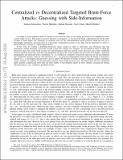Centralized vs Decentralized Targeted Brute-Force Attacks: Guessing with Side-Information
Author(s)
Salamatian, Salman; Huleihel, Wasim; Beirami, Ahmad; Cohen, Asaf; Medard, Muriel
DownloadAccepted version (677.1Kb)
Open Access Policy
Open Access Policy
Creative Commons Attribution-Noncommercial-Share Alike
Terms of use
Metadata
Show full item recordAbstract
© 2005-2012 IEEE. According to recent empirical studies, a majority of users have the same, or very similar, passwords across multiple password-secured online services. This practice can have disastrous consequences, as one password being compromised puts all the other accounts at much higher risk. Generally, an adversary may use any side-information he/she possesses about the user, be it demographic information, password reuse on a previously compromised account, or any other relevant information to devise a better brute-force strategy (so called targeted attack). In this work, we consider a distributed brute-force attack scenario in which m adversaries, each observing some side information, attempt breaching a password secured system. We compare two strategies: an uncoordinated attack in which the adversaries query the system based on their own side-information until they find the correct password, and a fully coordinated attack in which the adversaries pool their side-information and query the system together. For passwords X of length n, generated independently and identically from a distribution PX, we establish an asymptotic closed-form expression for the uncoordinated and coordinated strategies when the side-information Y(m) are generated independently from passing X through a memoryless channel PY|X, as the length of the password n goes to infinity. We illustrate our results for binary symmetric channels and binary erasure channels, two families of side-information channels which model password reuse. We demonstrate that two coordinated agents perform asymptotically better than any finite number of uncoordinated agents for these channels, meaning that sharing side-information is very valuable in distributed attacks.
Date issued
2020Department
Massachusetts Institute of Technology. Department of Electrical Engineering and Computer ScienceJournal
IEEE Transactions on Information Forensics and Security
Publisher
Institute of Electrical and Electronics Engineers (IEEE)